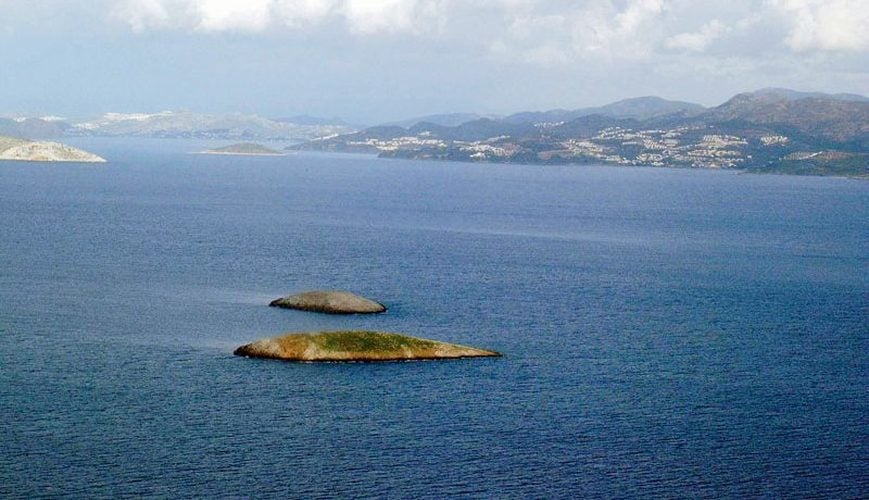
As unlikely as it may seem, a dispute over salvage rights between Turkish and Greek captains was the trigger for a series of events which escalated into a major international incident called the Imia Crisis.
The quickly-spiraling crisis saw the deployment of both countries’ special forces, the involvement of the United States, and the tragic loss of three Greek officers.
On December 26, 1995, the Turkish cargo vessel Figen Akat ran aground on the easternmost point of the two islets of Imia, which are just seven kilometers (4.4 miles) away from the coast of Bodrum, Turkey.
When a Greek tugboat approached to help, the Turkish captain insisted that the tug was in his country’s territorial waters. After the disabled vessel was eventually towed to a Turkish port, a routine salvage claim by the Greek skipper began the political wheels turning in the faraway Turkish capital of Ankara.
On December 27, 1995, Turkey contacted Greek authorities as a precursor to declaring ownership of the two tiny islets.
The Aegean had already been the backdrop for many years of repeated tensions between the two supposed allies over the ownership of islands, islets, territorial waters, and airspace.
What made the Imia situation different was the way in which the situation escalated, involving the U.S., European Union, and political leaderships of both countries.
Athens denied the Turkish sovereignty claim, citing a range of international treaties from 1923, 1932, and 1947, but it was not until later in January 1996 that events took a turn for the worse.
“Flag Wars” on Imia between Greece and Turkey
Having gone largely unnoticed at first, the Greek press seized on the issue, which became the first to confront new Greek premier Kostas Simitis. On January 25, 1996, Greeks who lived on the nearby island of Kalymnos sailed to Imia and raised the Greek flag there.
Turkish media suddenly took notice, and a team of reporters from the newspaper Hurriyet were dispatched to the islets (called “Kardak” in Turkish) to unfurl their own country’s flag on live television.
The Greek Navy intervened the next day, sailing to the islets and replacing the Turkish flag as an increasingly feverish atmosphere gripped both countries. Brand-new Greek Prime Minister Simitis began to trade barbs with his Turkish counterpart, Tansu Ciller.
Naval vessels from both nations then sailed to the hotspot, and Turkish troops in northern Cyprus were reported to have moved closer to the island’s dividing line, prompting an alert from Greek Cypriot forces.
Greek special forces were then landed on Imia and, on January 31st, Turkish forces followed suit. Four hours later, the crisis claimed its first lives, as a helicopter from the Greek frigate “Navarino” crashed while on a reconnaissance mission.
Three officers onboard the helicopter, Christodoulos Karathanasis, Panagiotis Vlahakos and Ektoras Gialopsos, were killed in the mishap.
Although the incident was covered up at the time, there are allegations the helicopter had been fired upon by Turkish forces.
It was only the shuttle diplomacy between Greece and Turkey by the U.S., as NATO’s largest military power, which halted the escalations and returned the situation to an enduring and frosty stalemate.
Greece and Turkey continue to disagree on the islets’ sovereignty and no military forces are stationed there. However, the issue continues to lead to dog fights between Athens and Ankara, often coming to the fore whenever Greek and Turkish ships or military forces come into close contact in the Aegean.
In February of 2018, a Turkish ship rammed into the Greek Coast Guard vessel Gavdos near Imia.
At the time, Greek defense sources said the Gavdos was stationary when the Turkish vessel hit it. The port authority confirmed that the Turkish patrol boat had entered Greek territorial waters.
Greece filed a strongly-worded demarche with the Turkish embassy in the aftermath of that incident.
“Earthquake diplomacy”
Although those tense days of 1996 have cast a long shadow over official Greek/Turkish relations, the tense situation was abated after the August 17, 1999 earthquake in Turkey.
The temblor devastated large parts of Turkey and killed seventeen thousand people according to official figures. Greece moved to send a great deal of aid, donating blood and extending a helping hand despite decades of mistrust.
When Athens was struck by an earthquake one month later, which killed 143 people, the Turkish people also responded, sending rescue workers and other support.
Still, these two tiny islets have been the scene of repeated games of “chicken” between Turkish and Greek forces. At times, seemingly unconnected events spark a renewal of tensions, such as the Greek courts’ refusal to extradite eight Turkish former servicemen for their alleged role in the July 2016 attempted coup in Turkey.
On Tuesday, defense authorities in Greece refuted reports in the Turkish media suggesting that Turkey had sent ships to the Imia islets which were preventing Greek vessels from approaching the area.
In a statement, Greece’s National Defense General Staff said the reports were part of customary efforts by Ankara to play up the Tuesday anniversary of the 1996 crisis, which brought the two countries to the brink of war.
Military sources emphasized that the situation around the islets was calm.
See all the latest news from Greece and the world at Greekreporter.com. Contact our newsroom to report an update or send your story, photos and videos. Follow GR on Google News and subscribe here to our daily email!



